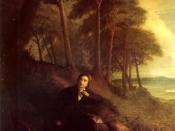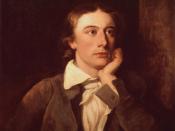Death: Personified
The Romantic period is a time of emotional expression. John Keats uses this movement to convey his personal emotions regarding Death. Through his effective work choice, he paints an image. An image so strong it as though the reader is seeing it on a giant canvas. However, each person's interpretations may vary on some images, but the underlying symbolic representation of Death is apparent to all. He personifies Death in various selections, and creates the sense that why fight it, it our fate is sealed.
As all poets and writers convey events in their lives, Keats's is no different. One could safely assume that his own ailment of tuberculosis is the reason why he personifies Death so much in his works. "Ode on Melancholy" is an intense example:
She dwells with Beauty-Beauty that must die; and Joy whose had is ever at his lips Bidding adieu; and aching Pleasure nigh Turing to Poison while the bee-mouth sips; Aye in the very temple of Delight Veiled Melancholy has her sovereign shrine Though seen of one save him whose strenuous tongue Can burst Joy's grape against his palate fine; His soul shall taste the sadness of her might And be among her cloudy trophies hung (608).
In this selection, Death has been personified as a veiled woman, a beautiful woman, who seduces a man with poisonous grapes. When he bites into them, the juice bursts in his mouth, which causes him demise, and his soul, she claims. Keats's effective word choice conjures very vivid images, while giving Death a body and demonstrating her purpose. He continues to convey to the readers that no matter what we do, Death will happen to us all.
"Ode to a Nightingale" demonstrates the inevitability of death, and how one may even welcome it:
Here, where men sit and hear each other groan; Where palsy shakes a few, sad, last fray hairs, Where youth grows pale, and specter-thin, and dies; And leaden-eyed despairs; Where beauty cannot keep her lustrous eyes, Or new love pine at them beyond tomorrow. (606)
No matter what, Death will happen to us all. Time plays us like a puppet, it changes our appearance, and with time, beauty fades. What is new today will be old tomorrow, and soon will be nothing, but if a memory. Knowing this Keats's takes it a step further by saying that he welcomes dying. Keats's continues this thought in the sixth stanza:
Darkling I listen; and for many a time I have been half in love with easeful Death, Called him soft manes in many a mused rhyme, To take into the air my quiet breath; Now more than ever seems it rich to die,
To cease upon the midnight with no pain, while thou art pouring forth thy soul abroad in such an ecstasy! Still wouldst thou sing, an I have ears in vain to thy high funeral song become a sod. (606)
This not only expresses Keats's personal battle with his own demise, but also illustrates that it will come, it is as real as the air we breathe, and it is our fate.
John Keats's is a brilliant British poet whose works are not only illustrated with eloquent word choice but his imagery as well. In his poems, he captivates the reader with his emotional representation of inanimate substance. Through this, he hypnotizes the reader, and conjures images that entice the creativity of one's psyche. His works all have an underlying theme, Death. He illustrates his personal views and beliefs on what so many fear. He exercises this human fear to invoke the reader's emotions. The emotions of loss, sadness, and helplessness, not only felt by person who may be dying, but also for those around them as well. For some Death will come quicker than unto others. We have nothing to fear for living is the test, and Death always greets us with open arms.
Works Cited
Keats, John. "Ode to a Nightingale." The Norton Anthology World Masterpieces: the
Western Tradition. Vol. 2. Ed. Sarah Lawall, Maynard Mack. 500th Fifth Avenue, NY: W. W. Norton & Company, Inc., 1999. 606-608.


